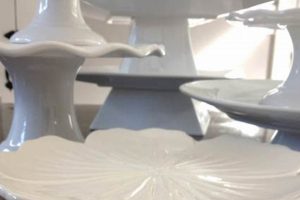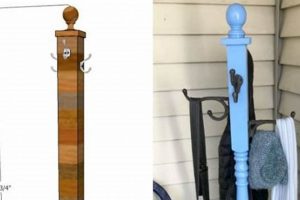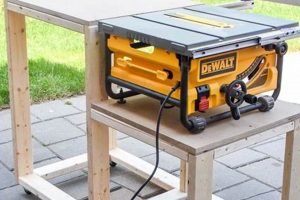A homemade apparatus designed to facilitate the process of correcting imperfections in bicycle wheel alignment. These constructions typically allow for the wheel to be mounted and spun freely while calipers or indicators are used to identify deviations from true, enabling precise adjustments to spoke tension.
The creation of such a device offers a cost-effective alternative to purchasing commercially manufactured equipment. This approach empowers cycling enthusiasts and mechanics to maintain wheel integrity without significant financial investment. The concept aligns with a broader movement towards resourcefulness and self-sufficiency within the cycling community.
The following sections will explore the various design considerations, material options, and construction techniques involved in building a functional and accurate device for wheel alignment correction. This will include an overview of essential tools and a step-by-step guide to creating several different examples, ranging from simple to more complex designs.
Essential Considerations for a Homemade Wheel Alignment Device
This section provides crucial guidelines for ensuring the accuracy and effectiveness of a self-constructed wheel alignment tool. Adherence to these principles will result in a device capable of producing professional-grade results.
Tip 1: Rigidity is Paramount: The frame must resist deflection during use. Employ robust materials such as steel or thick-walled aluminum to minimize movement and ensure consistent readings.
Tip 2: Caliper Precision: The calipers, or indicators, should offer fine adjustment and minimal play. Dial indicators or vernier calipers provide superior accuracy compared to simpler pointer mechanisms.
Tip 3: Secure Wheel Mounting: The axle mounting points require a secure locking mechanism to prevent slippage. Cones or precisely machined surfaces will maintain consistent positioning during the wheel truing process.
Tip 4: Adjustable Caliper Arms: The ability to adjust the caliper arm height is essential to accommodate various wheel sizes. Ensure smooth and precise adjustment mechanisms for optimal versatility.
Tip 5: Stable Base: A broad, stable base will prevent tipping during operation. Secure the device to a workbench or utilize a weighted platform to enhance stability.
Tip 6: Consistent Calibration: Regularly check the calibration of the calipers against a known true surface. This proactive measure will identify and address any deviations in measurement.
Tip 7: Accurate Measurement Points: The measurement points on the calipers must contact the wheel rim perpendicularly. Angled contact will introduce errors in the truing process.
Prioritizing rigidity, precision, and stability during construction will yield a valuable tool for wheel maintenance and repair. A well-executed homemade wheel alignment device can deliver results comparable to commercially available equipment.
The following sections will delve into specific design options and construction methods, illustrating how to implement these essential considerations in practice.
1. Frame Rigidity
Frame rigidity is a critical factor in the performance and accuracy of any wheel alignment tool, especially in the context of self-constructed devices. Inadequate stiffness introduces errors that compromise the truing process.
- Impact on Measurement Accuracy
A flexible frame deflects under the tension of the wheel and the applied forces of measurement, leading to inconsistent and unreliable readings. This directly affects the ability to accurately identify and correct deviations in wheel alignment. Even slight deflections can magnify errors, particularly when dealing with fine adjustments to spoke tension.
- Material Selection Implications
The choice of materials significantly influences frame rigidity. Steel, with its high modulus of elasticity, provides superior stiffness compared to wood or thin-walled aluminum. While alternative materials may offer cost savings or ease of fabrication, they often necessitate more robust designs to compensate for their lower inherent stiffness. The trade-off between material properties and design complexity must be carefully considered.
- Design Considerations for Stiffness
Beyond material selection, structural design plays a crucial role in achieving adequate rigidity. Triangular bracing, gussets, and box-section construction techniques effectively distribute loads and minimize deflection. Proper joint design, utilizing welding or robust fasteners, is essential to maintain structural integrity under stress. A well-designed frame will exhibit minimal flexure, even when subjected to significant loads during the wheel truing process.
- Vibration and Resonance Effects
Inadequate frame rigidity can also amplify vibrations, further hindering accurate measurement. Resonance frequencies within the frame can cause oscillations that obscure subtle deviations in wheel alignment. Damping materials or design modifications can be implemented to mitigate these effects and improve the overall stability and precision of the tool.
The preceding points underscore the critical role of frame rigidity in achieving accurate and reliable results with a self-constructed wheel alignment device. A well-engineered frame, utilizing appropriate materials and construction techniques, forms the foundation for a functional and precise tool for wheel maintenance and repair. Without it, even the most careful spoke adjustments may prove ineffective.
2. Caliper Precision
Caliper precision represents a fundamental aspect of any wheel alignment apparatus, dictating the accuracy with which radial and lateral runout can be detected. Within the context of self-constructed wheel alignment devices, the selection and implementation of precise calipers become paramount to achieving acceptable truing results.
- Measurement Resolution and Accuracy
The resolution of the calipers defines the smallest detectable increment of deviation. A resolution of 0.01mm is typically desirable for achieving professional-grade results. Accuracy, in turn, reflects the degree to which the measured value corresponds to the actual deviation. The combination of high resolution and accuracy minimizes measurement errors and facilitates fine adjustments to spoke tension. For example, a dial indicator with a calibrated range and minimal hysteresis is preferred over simple pointer-based indicators.
- Caliper Mounting and Stability
Even calipers with inherent precision can yield inaccurate readings if improperly mounted. A rigid and stable mounting system is crucial to prevent vibration or deflection during measurement. The caliper arms should be securely attached to the frame, minimizing any potential for movement or play. For instance, mounting a dial indicator on a solid steel arm, bolted directly to the apparatus frame, will improve stability compared to a flexible or loosely connected mounting arrangement.
- Contact Point Geometry and Material
The geometry and material of the caliper contact point influence the consistency and repeatability of measurements. A smooth, spherical contact point, made of a non-marring material such as Delrin or nylon, minimizes friction and prevents damage to the wheel rim. The contact point should be perpendicular to the rim surface to ensure accurate measurement of radial and lateral runout. An example of poor practice would be using a sharp metal point that scratches the rim and introduces inconsistent readings due to varying contact pressure.
- Calibration and Zeroing Procedures
Regular calibration and zeroing of the calipers are essential for maintaining accuracy over time. Calibration involves comparing the caliper readings to a known reference standard. Zeroing ensures that the caliper reads zero when in contact with a perfectly true surface. This process compensates for any drift or wear that may occur in the caliper mechanism. An example of calibration might involve using gauge blocks to verify the accuracy of a dial indicator at various points across its measurement range.
The interplay of measurement resolution, mounting stability, contact point characteristics, and calibration procedures determines the overall precision of the caliper system. In the context of self-constructed wheel alignment devices, careful attention to these factors is essential for achieving accurate and repeatable truing results. Compromising on caliper precision ultimately limits the effectiveness of the entire device.
3. Axle Security
Secure axle mounting is a fundamental requirement for any functional device intended for wheel alignment, including self-constructed models. Inadequate fixation compromises measurement accuracy and introduces the potential for wheel slippage during spoke adjustments.
- Consistent Wheel Positioning
The primary function of secure axle mounting is to maintain consistent wheel positioning throughout the truing process. Any movement or shifting of the wheel relative to the measurement calipers introduces errors and renders spoke adjustments ineffective. A robust locking mechanism ensures that the wheel remains precisely aligned with the measuring instruments.
- Minimizing Vibrations and Oscillation
A secure axle mounting system dampens vibrations and oscillations that can arise during wheel spinning or spoke manipulation. These vibrations interfere with accurate measurement and can lead to inconsistent readings. A tight, stable connection between the axle and the tool’s frame minimizes unwanted movement and enhances measurement precision.
- Load Distribution and Frame Stress
The axle mounting points must effectively distribute the load of the wheel across the device frame. Uneven load distribution can induce stress and deflection in the frame, further compromising measurement accuracy. A well-designed mounting system evenly disperses the wheel’s weight, minimizing frame distortion and maintaining consistent caliper alignment.
- Compatibility with Various Axle Types
An ideal design accommodates various axle types, including quick-release skewers, thru-axles, and solid axles. Interchangeable adapters or adjustable mounting mechanisms enhance the tool’s versatility and expand its usability across different bicycle wheel configurations. This adaptability is particularly valuable for individuals working on a diverse range of bikes.
These facets underscore the critical relationship between axle security and the overall effectiveness of a self-constructed wheel alignment device. A robust and versatile axle mounting system is essential for achieving accurate and reliable truing results, regardless of wheel type or spoke adjustment technique.
4. Adjustability
Within the context of self-constructed wheel alignment equipment, adjustability emerges as a critical design parameter influencing the tool’s versatility and effectiveness. The capacity to adapt to varying wheel sizes, axle types, and measurement requirements directly determines the range of wheels that can be trued accurately.
- Caliper Arm Height Adjustment
Accommodating wheels of different diameters necessitates a mechanism for adjusting the vertical position of the caliper arms. This adjustment ensures that the measurement points contact the rim surface correctly, regardless of wheel size. A system employing sliding supports or threaded rods allows for precise positioning, optimizing the measurement process for a diverse array of wheel sizes, from smaller BMX wheels to larger 29-inch mountain bike wheels.
- Axle Mounting Position Adjustment
Different axle widths and dropout configurations demand adaptability in the axle mounting system. Adjustable cones or sliding dropouts allow for the secure mounting of wheels with varying hub widths and axle standards, including quick-release skewers, thru-axles, and solid axles. The ability to modify the axle mounting position ensures compatibility with a wide spectrum of bicycle wheels.
- Caliper Position Adjustment (Lateral)
The lateral positioning of the calipers must be adjustable to accommodate rims of varying widths and to facilitate accurate measurement of lateral runout. A system incorporating sliding caliper mounts or adjustable arms allows for precise positioning of the calipers relative to the rim surface, ensuring accurate detection of side-to-side deviations. This is particularly important when working with rims designed for different tire widths or when addressing lateral wobble.
- Gauge Calibration and Zeroing Adjustments
Fine-tuning adjustments within the measuring apparatus, such as the dial indicators, are essential to calibrate and ensure the zero point for measurement. Adjustable screws, spring tension settings, and precise movement in caliper parts helps ensure calibration. This fine tuning is important for proper functionality and measurements of the wheel truing process.
In summary, the integration of adjustable features within a self-constructed wheel alignment device significantly enhances its utility and extends its lifespan. The capacity to adapt to diverse wheel configurations and measurement needs underscores the importance of adjustability as a key design consideration.
5. Base Stability
Base stability represents a cornerstone of effective “diy truing stand” design. A stable foundation mitigates vibrations and prevents unwanted movement, thereby ensuring accurate measurements and reliable spoke adjustments. Its importance cannot be overstated, as any instability directly translates to errors in wheel alignment.
- Mitigation of Vibrations
Vibrations, whether from external sources or inherent in the truing process itself (such as spoke tensioning), can significantly impair measurement accuracy. A heavy and rigid base dampens these vibrations, allowing for more precise observation of runout. For example, a base constructed from thick steel plate provides superior vibration damping compared to a lightweight wooden structure. The implications are clear: a less stable base yields less reliable results.
- Prevention of Tipping and Movement
The forces exerted during spoke tensioning can easily destabilize a poorly designed device. A wide and low base reduces the risk of tipping, while non-slip feet prevent the device from sliding across the work surface. The stability prevents unintended shifts, ensuring that adjustments are made based on accurate assessments rather than induced movement. For instance, a truing stand with a narrow base is prone to tipping if one attempts to make aggressive spoke adjustments.
- Material Properties and Construction Techniques
The materials and construction methods employed directly influence the overall stability. Dense materials, such as cast iron or concrete, provide inherent stability due to their mass. Joining techniques, such as welding or robust bolting, ensure that the base maintains its structural integrity under load. An example might be a concrete-filled steel tube base, offering both mass and structural rigidity, compared to a base constructed from loosely joined PVC pipes.
- Surface Contact and Leveling
The manner in which the base interacts with the work surface is also critical. A flat, even base ensures consistent contact with the surface, preventing rocking or wobbling. Adjustable feet allow for leveling the device on uneven surfaces, further enhancing stability. For example, adjustable leveling feet can compensate for imperfections in a workbench, ensuring that the truing stand remains perfectly vertical, regardless of the underlying surface.
In conclusion, base stability forms a critical link in the performance of a “diy truing stand.” From vibration mitigation to preventing unwanted movement, a well-designed and constructed base provides the necessary foundation for accurate wheel alignment. A stable base yields a more reliable and effective tool for maintaining bicycle wheels.
6. Measurement Accuracy
The achievable precision of a self-constructed wheel alignment apparatus is directly and inextricably linked to the accuracy of the measurements it facilitates. Errors in measurement propagate directly into the wheel truing process, resulting in suboptimal wheel alignment. The relationship is causal: enhanced measurement accuracy leads to more precisely trued wheels; conversely, diminished measurement accuracy yields wheels with residual runout.
Measurement accuracy, in this context, encompasses both the resolution of the measuring instruments (typically dial indicators or calipers) and the stability of the entire setup. For example, a dial indicator with a resolution of 0.01 mm provides significantly greater precision than a rudimentary pointer-based indicator. Similarly, a frame that is prone to vibration or deflection under load introduces systematic errors that negate the inherent accuracy of the measuring instruments. Practical application requires minimizing any form of error that interferes with a consistent reading of the measurement process.
In summary, the pursuit of improved wheel alignment through self-construction necessitates a rigorous focus on measurement accuracy. The limitations of the measuring instruments and the structural integrity of the apparatus must be addressed to minimize error propagation. The practical significance of this understanding lies in the ability to construct a tool that enables meaningful improvements in wheel trueness, ultimately enhancing the performance and longevity of bicycle wheels. Ignoring accuracy is simply a waste of time and resources.
Frequently Asked Questions Regarding Self-Constructed Wheel Alignment Devices
This section addresses common inquiries concerning the design, construction, and utilization of homemade wheel alignment equipment. The aim is to provide clarity on frequently encountered challenges and misconceptions.
Question 1: What is the minimum level of precision required for calipers used in a self-constructed device?
A minimum resolution of 0.05mm is generally acceptable for basic wheel truing. However, a resolution of 0.01mm is recommended for achieving professional-grade accuracy and minimizing runout.
Question 2: Is it possible to construct a functional device using only wood as the primary building material?
While feasible, a wood-based construction necessitates robust design principles and careful material selection to mitigate flexibility and ensure accurate measurements. Reinforcements and substantial bracing are essential.
Question 3: How critical is it to have adjustable caliper arms for varying wheel sizes?
Adjustable caliper arms are highly recommended for versatility, allowing the device to accommodate a wider range of wheel diameters. A fixed-height design significantly limits its usability.
Question 4: What are the potential safety hazards associated with using a homemade wheel alignment device?
Potential hazards include sharp edges on the constructed device, pinch points in moving parts, and the risk of wheel instability during spoke tensioning. Proper construction techniques and cautious operation are essential.
Question 5: How frequently should a self-constructed wheel alignment device be calibrated?
Calibration should be performed periodically, ideally before each use, to ensure accuracy. This involves verifying the caliper readings against a known reference standard and making any necessary adjustments.
Question 6: What are the most common sources of error in self-constructed wheel alignment devices?
Common error sources include frame flex, caliper instability, inconsistent axle mounting, and inadequate calibration. Addressing these factors is crucial for achieving accurate and reliable results.
In summary, the effectiveness of a self-constructed wheel alignment device hinges on careful design, precise construction, and diligent maintenance. Addressing the factors outlined above contributes significantly to achieving optimal results.
The following section will provide detailed instructions for building several different variations of the device.
diy truing stand
The preceding exposition has elucidated the multifaceted aspects of self-constructed wheel alignment apparatus. Design considerations encompassing frame rigidity, caliper precision, axle security, adjustability, base stability, and measurement accuracy have been systematically examined. The interplay of these elements dictates the functionality and effectiveness of any “diy truing stand”.
Ultimately, the creation of such a device represents a commitment to precision and resourcefulness within the realm of bicycle maintenance. While commercial options exist, the self-made alternative fosters a deeper understanding of wheel mechanics and empowers individuals to maintain their equipment with greater control. Continued refinement of construction techniques and adherence to fundamental engineering principles will further elevate the capabilities of “diy truing stand” designs, contributing to the sustained pursuit of optimal wheel performance.







